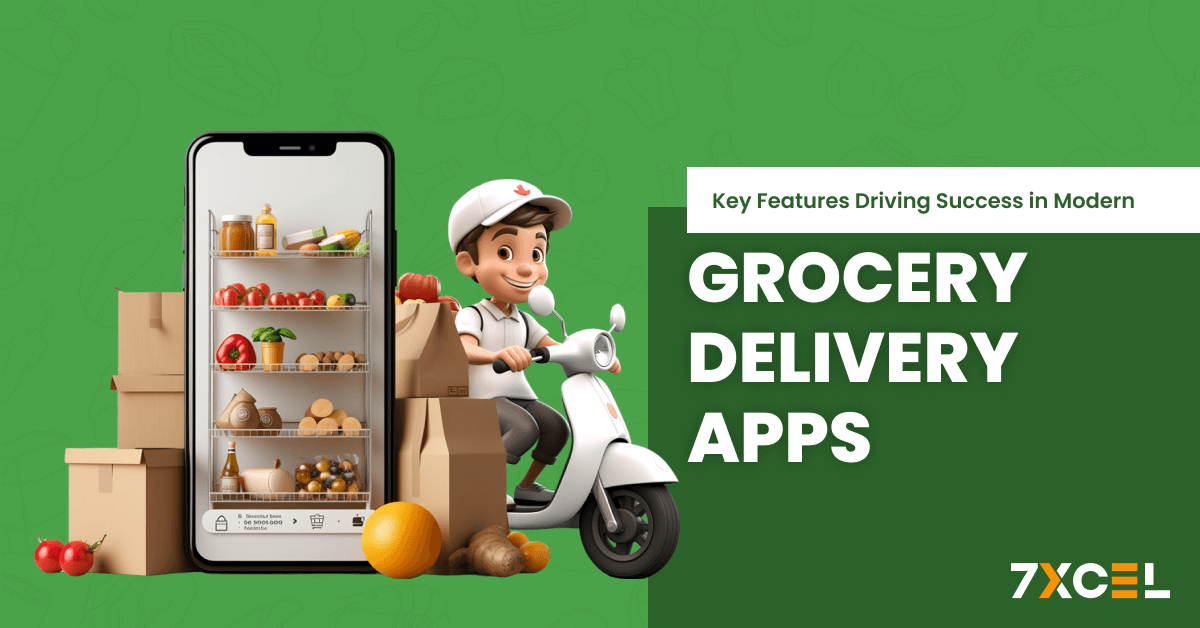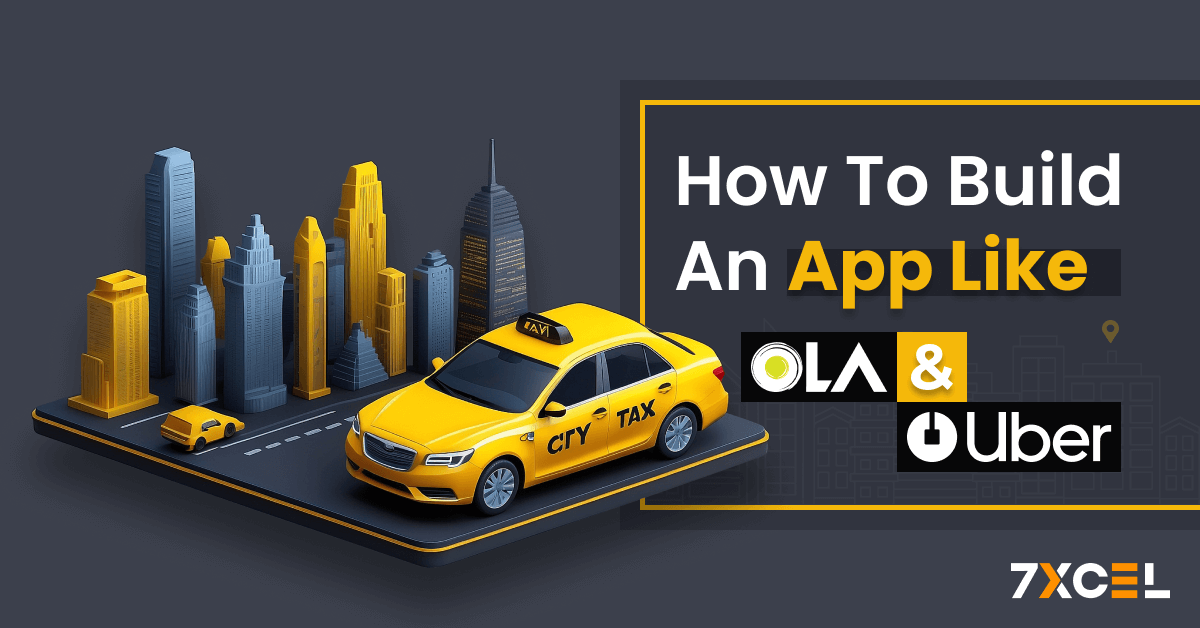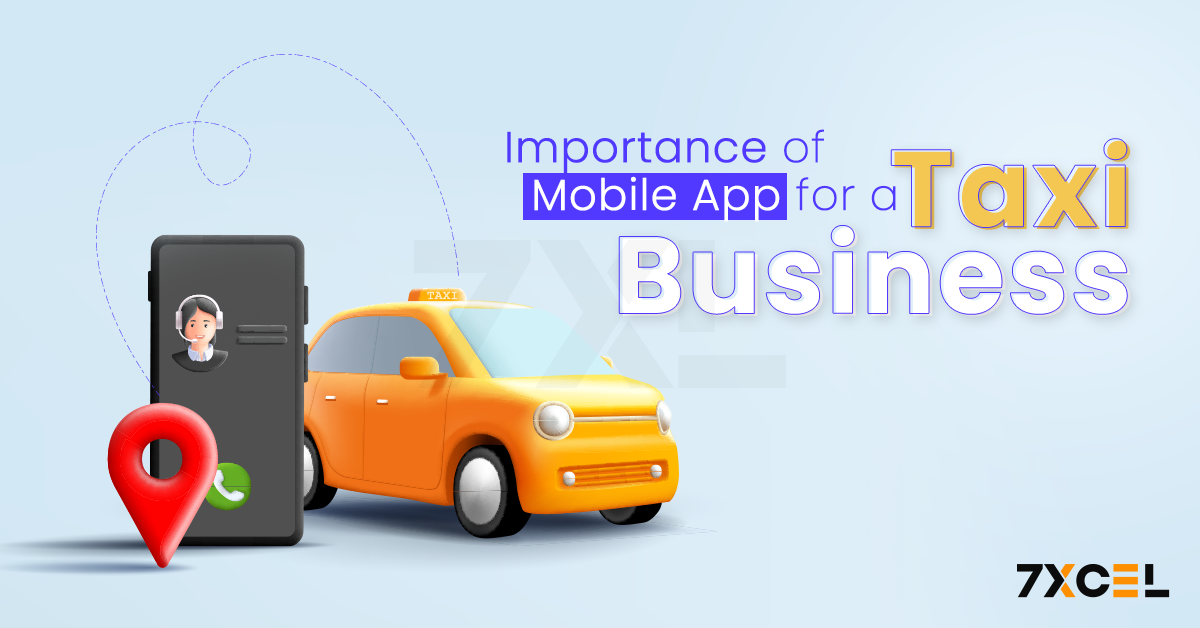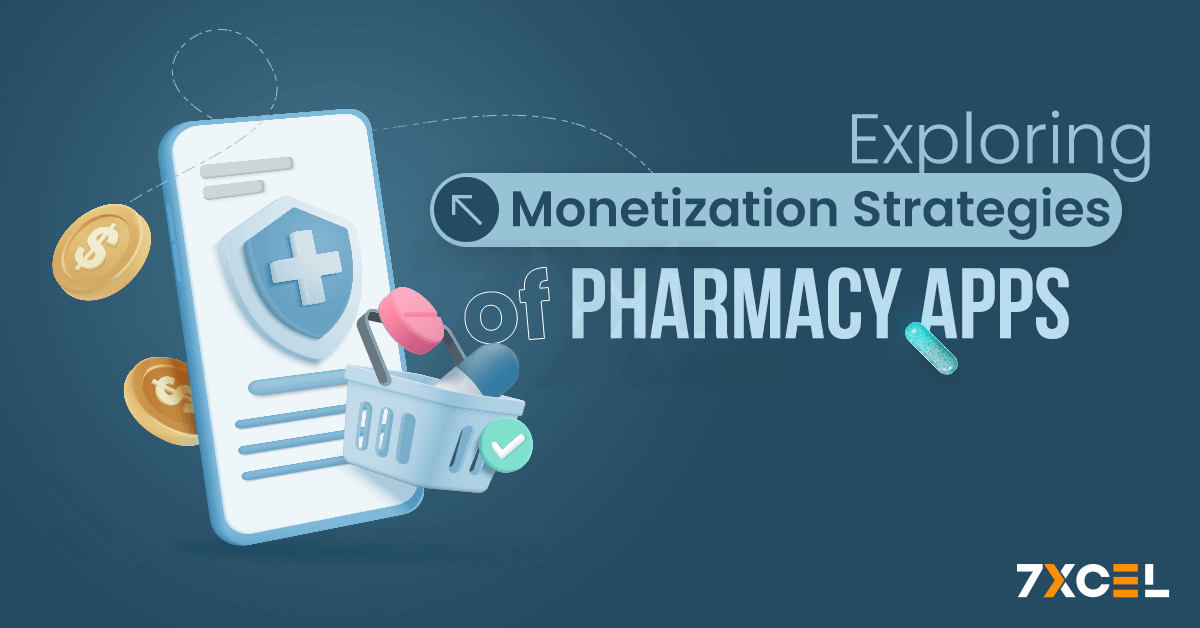Quick Summary:
Grocery Apps are increasingly important from the viewpoint of a customer’s desire to secure convenient and efficient purchasing. An essential subset of grocery delivery app features, enhanced with cognitive technology, defines user experience in the competitive grocery app market. Here are some critical features to be incorporated into a grocery app. Also check how cognitive technology can take your business to the next level.
In this blog, we’re going to discuss📝
Grocery apps have become essential in consumers’ lives, providing the convenience of shopping anytime and anywhere. Over the past decade, the industry has transformed due to advancements in mobile technology and changing consumer behavior. According to eMarketer, by 2021, 54% of total e-commerce sales came from mobile commerce, highlighting the increasing reliance on mobile apps for shopping.
However, the grocery app market is highly competitive, requiring apps to excel in user experience and functionality to retain customers. Cognitive technologies, like AI and machine learning, are critical in this space. A PwC study found that 72% of business leaders see AI as a business advantage, underscoring the importance of cognitive tech in the future of grocery shopping.
These technologies enhance grocery apps by offering better customization, customer service, inventory management, and dynamic pricing, ultimately driving user engagement and loyalty. This blog will explore the must-have features of grocery delivery apps and how cognitive technology can elevate them to take your business to the next level.
Must-Have Grocery Delivery App Features
There are some fundamental must-have grocery delivery app features that boost contentment among users, thus growing your business: These ensure that the shopping process by the consumer is seamless, intuitive, and effective to the point of exceeding expectations. Here are those must-have functionalities in every grocery app for boosting user satisfaction and growing your business:
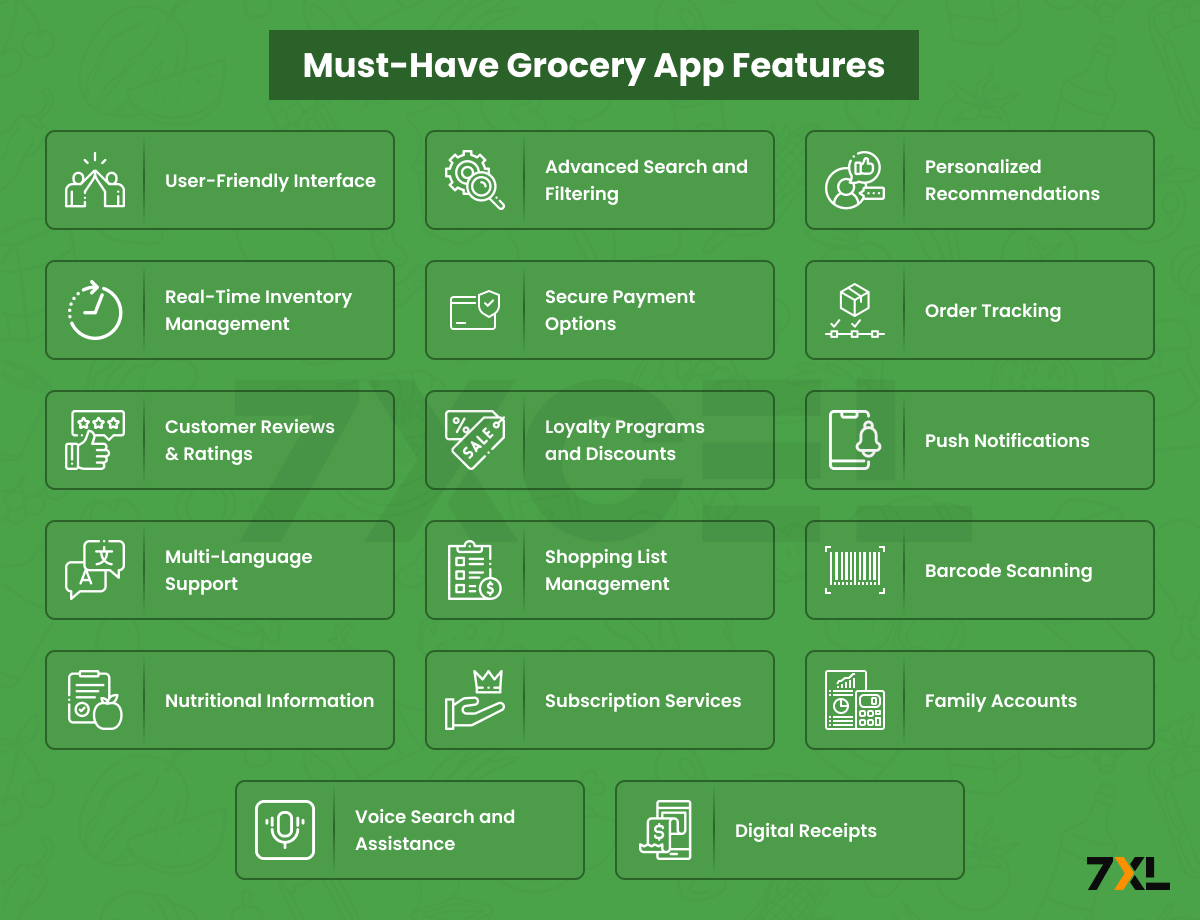
User-Friendly Interface
Significance: Clean and intuitive design allows users to navigate easily into the application, to search for products, and to make their purchase decisions.
Implementation: Clean labels, simplified navigation menus, and aesthetically pleasing layouts. Research provided by the Nielsen Norman Group found that usability was the number one factor in satisfaction for users.
Advanced Search and Filtering
Significance: A powerful filter feature in advanced search allows the customer to identify the products easily and quickly.
Implementation: Install the filters for categories, brands, price, dietary needs, and much more. The search experience can become much better by putting in the usability feature of auto-suggestions and auto-correction.
Personalized Recommendations
Significance: The personalized product recommendations that mirror the consumer’s previous purchases and browsing behaviour are further value additions for the customer shopping experience.
Implementation: Execute algorithms on user data to tailor the product to the liking of the user, personalizing the experience and making it engaging. According to Accenture, 91% of the consumer is more likely to shop with the brands that provide relevant offers and recommendations.
Real-Time Inventory Management
Significance: Information on product availability in real time will prevent eventual difficulties with out-of-stock goods, therefore contributing to smooth shopping.
Implementation: To develop inventory management systems that will be in sync with the app to assure users that the stock levels will update and remain accurate at all times.
Secure Payment Options
Importance: Multi-payment methods, such as credit/debit cards, e-wallet, and even net banking, enable with safe transaction protocols.
Implementation: To ensure that all user data is within PCI Compliance and that all methodologies of encryption are used to secure all user data while all transactions are being processed. With mobile payments worth over $3 trillion expected to be realized by 2025.
Order Tracking
Importance: Real-time order tracking, from dispatch to delivery, helps the users be aware of the status of their purchase.
Implementation: Integrate GPS and send regular status updates either through a push notification or SMS to make the process of service delivery transparent, at the same time reducing uncertainty.
Customer Reviews and Ratings
Importance: User-generated reviews and ratings help empower customers to make informed purchasing decisions.
Implementation: Reviews with rating of products, bring up a sense of trust amidst the different users and enable businesses to harness consumer feedback for improvements. On average, 87% of consumers read online reviews for local businesses.
Loyalty Programs and Discounts
Importance: The introduction of loyalty programs, discounts, and special offers when integrated induces return buying and gains customer loyalty.
Implementation: Reward customers with points for purchases, special discounts, and special promotions available in general to increase participation and general customer lifetime value.
Push Notifications
Importance: Updates on orders, push notifications for special promotions, and offers customized for the consumer all create opportunities for continued engagement with the app.
Implementation: Use push notifications to update users on anything new that comes up, such as offers, tell them what their order status is, and make any relevant recommendations for a better user experience to repeat use
Multi-Language Support
Importance: The multi-language support will cater to the varied user base, thereby enabling them access and satisfaction
Implementation: Language changes should be enabled in the application settings to allow the users to make a selection based on their preferences, which will ensure that the application is more inclusive.
Shopping List Management
Importance: Users can create, save, and share shopping lists to thereby plan and organize grocery shopping more easily.
Implementation: Features like add to list, save your favourites, and share lists with your family members make it very easy and time-efficient to shop.
Barcode Scanning
Importance: A grocery delivery app features that offers users the ability to scan barcodes of products in their homes and fast-add them to their shopping list or cart without wasting time typing.
Implementation: With the barcode scanning capability, one can easily reorder items that are typically on the shopping list and thereby make it much more realistic.
Nutritional Information
Importance: The detailed nutritional information of the product can guide time-pressed customers to a wise decision.
Implementation: Add him to include calories, ingredients, and dietary notes to attract those health-conscious customers on the go
Subscription Services
Importance: Repeat delivery of frequently used products, where a customer can subscribe to have essentials delivered each week or month.
Implementation: Automate all subscription services and repeat orders to remove all friction for a customer.
Family Accounts
Importance: Multi-user accounts that allow all family members to share and collaborate on one account for shopping lists and shopping.
Implementation: This will help bring families closer and streamline the efforts of group shopping with shared shopping lists and the order history for easy re-ordering of past products.
Voice Search and Assistance
Importance: Voice search makes it easy for users to search for products and keep their shopping list updated using a spoken word.
Implementation: Add more convenience and ease in accessibility through in-app NLP powered voice search.
Digital Receipts
Importance: They can easily access digital receipts, eliminating the wasting of paper and even helping users to remember the history of their purchases.
Implementation: E-receipts can be displayed in-app so that customers can have them mailed to their inbox and for their own record.
These grocery delivery app features must empower the customers to shop effectively and comfortably, with a high level of personalization. It should go beyond user satisfaction and driving resolution, resulting in business success, building engagement, and ensuring loyalty.
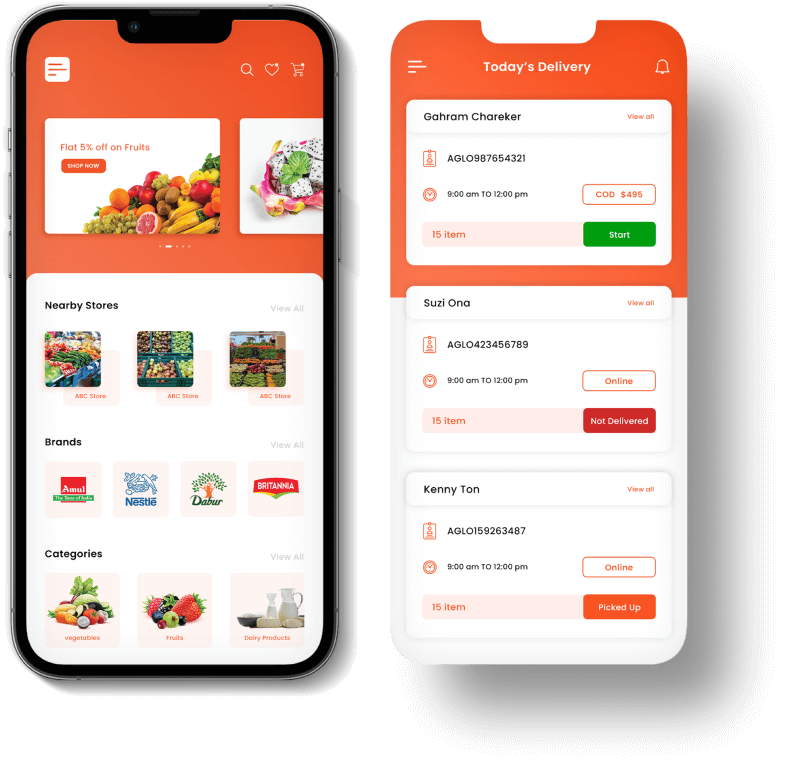
Interested to develop a standout grocery delivery app?
Revamp your grocery business with 7xcel’s cutting-edge app development, extending your influence online.
How Cognitive Technology Can Boost Your Business
AI/ML-fuelled cognitive technologies, can empower grocery apps functionality and scope for user experience. Here’s how it can help you grow your business:
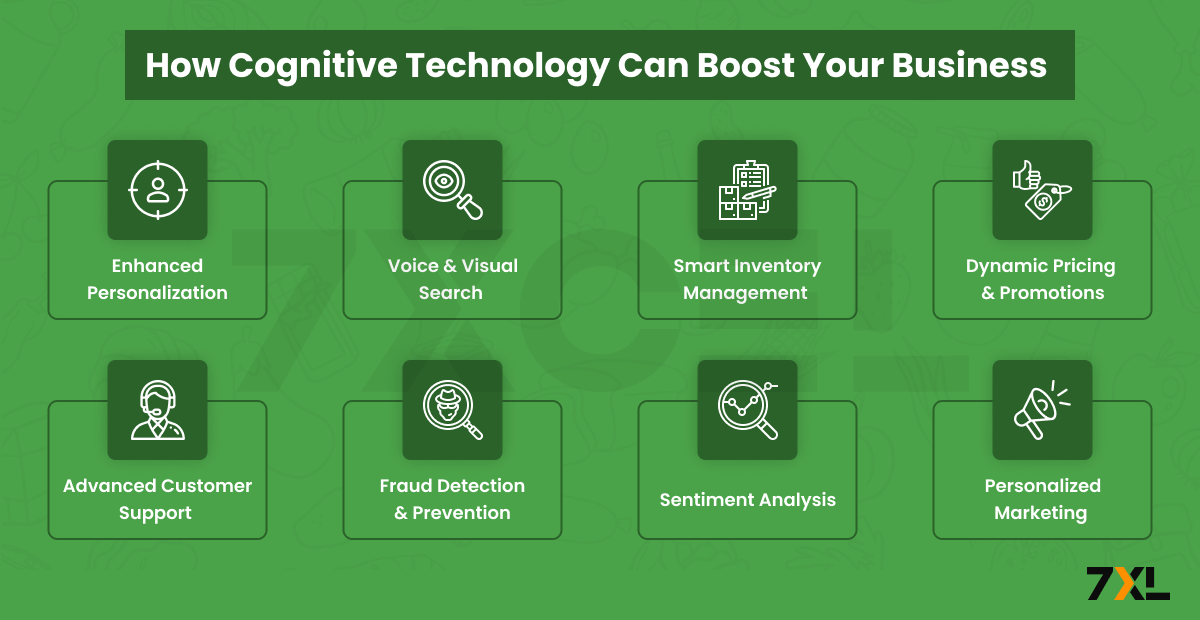
Enhanced Personalization
AI and ML Algorithms: Cognitive technologies follow the data of the user around to give a more hyper-personal experience in shopping. At play is the purchase history, including preferences, juxtaposed to what the product predicts is in store for the future. Personalized AI can boost customer satisfaction by 20%, according to Accenture.
Impact: Personal recommendations help not only in enhancing the quality of user experience but also in simultaneously increasing the sales and customer loyalty through the use of the method that actually ensures the following of relevant shopping processes.
Voice and Visual Search
Natural Language Processing (NLP): Search for any product by just talking about the product you want right there, thereby making this shopping process even more convenient and handy. Visual search: Upload photos for similar products within the app.
Impact: Voice and visual search through the app simplify and speed up the search process for goods and products, evidently making it more interesting and gratifying for the users.
Smart Inventory Management
Predictive Analytics: Stock is determined based on predictive analytics, which is an in-depth analysis done on historical data, seasonal behavior, and purchase patterns. This will make sure the right amount of inventory at store level and will minimize the risk of out-of-stock and overstock inventory. According to McKinsey’s research, predictive analytics can even save up to 30% in inventory-related costs.
Impact: Efficient inventory management is done to reduce costs of operation and to ensure that customers would find what they need in stock, meaningfully enriching their shopping experience and avoiding loss of sales.
Dynamic Pricing and Promotions
AI Algorithms: AI algorithms can then also be used to analyze competitor pricing, changes in demand, and customer behaviour to dynamically adjust prices and promotions and maximize sales and profit.
Impact: Dynamic pricing models would help businesses to remain competitive and, by doing so, have their profits optimally realized; attract more customers through targeted promotions; and come up with competitive pricing schemes.
Advanced Customer Support
AI Chatbots: AI chatbots can be used to provide real-time, 24/7 customer service; they respond to questions, take orders, and solve problems without human intervention. In 2022, Gartner predicts that 70% of all customer interactions will involve chatbots or emerging technologies.
Impact: AI chatbots render customer service effective to an extent that inquiries can be effectively responded to, thus likely to increase customer satisfaction and cut the time of human resources invested in simpler tasks to attend to more complex ones.
Fraud Detection and Prevention
Machine Learning Models: Cognitive technologies could very well have the power to analyze the prevalent transactional pattern that goes out of order, so as to detect fraudulent activities and secure the transactions for the benefit of the customer.
Impact: Increased security controls of the business against fraud, gaining trust, and ensuring that the integrity of the transactions is intact for both the business and its customers.
Sentiment Analysis
Text Analytics: Cognitive technologies evaluate customer sentiments by analyzing customer reviews and feedback that the business entities can further identify its customers and model products and services according to the understanding gained.
Impact: Sentiment analysis literally explains customer preferences and pain points and acts as the point of deliberation in any decision taken towards enhancing products or services for a respective business.
Personalized Marketing
Data-Driven Insights: Now, see how AI can enable customer segmentation by behaviour and preferences to provide highly targeted marketing campaigns. Personalized marketing messages maintain a 10-15% increase in the conversion rate.
Impact: Easily reach the right audience with the right message through targeted marketing campaigns; engaging such an audience results in sales.
Therefore, cognitive technologies will therefore, for sure, make grocery applications exceed the requirements of the customers rather than only meeting them with a personalized shopping experience. Their potential future would be in leveraging these advanced technologies to stay a step ahead in competition.
Steps to Integrate Cognitive Technology in Grocery Apps
The adoption of cognitive technology in grocery apps could enhance user experience, operational effectiveness, and the delivery of personal recommendations. Partnering with a specialized Grocery Delivery App Development Company can help you build a cutting-edge platform that leverages artificial intelligence and machine learning effectively.
These experts can guide you through integrating advanced features like personalized recommendations, real-time inventory management, and predictive analytics, ensuring your app remains relevant in the fast-changing market and user-friendly. The below section states several significant measures necessary to implement AI and ML in grocery apps.
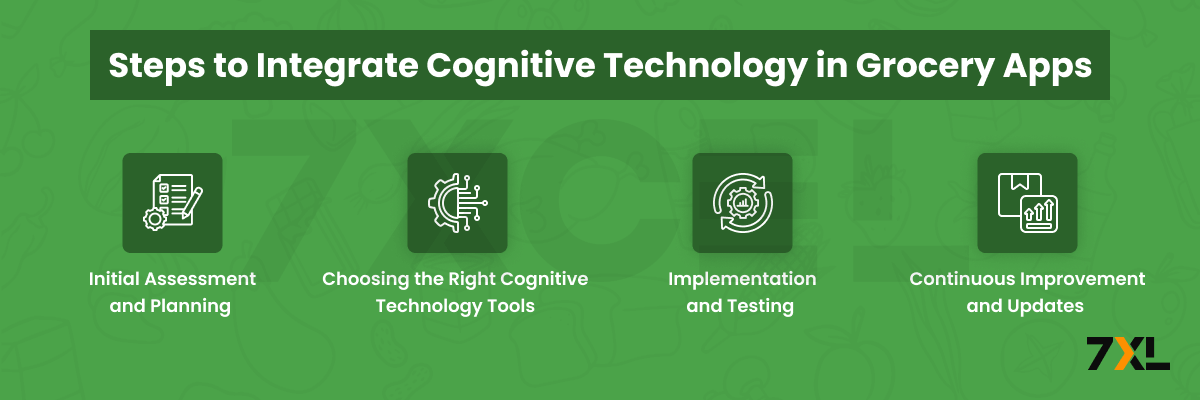
Initial Assessment and Planning
- Analyze the Current Setup: Analyze the current infrastructure in the grocery app and areas where cognitive technology can bring in maximum benefit. The evaluation should be made in terms of the existing practices of data management, user interfaces, and backend systems.
- Identify Pain Points: Identify the specific challenges or constraints that could potentially be addressed through the application of cognitive technology; for example, customer service inefficiency, inventory mismanagement, or security vulnerabilities.
- Define the goals and objectives: Define what you would like to achieve with the implementation of cognitive technology. It can be through the goals of improving user experience, optimizing inventory management, or enhancing security features.
- Stakeholder Engagement: Such planning ought to involve important stakeholders: the system developers, data scientists, and business managers, so important, specific needs and expectations are clearly understood.
Choosing the Right Cognitive Technology Tools
- Research and Select Tools: Evaluate the cognitive technology tools and platforms landscape to select those that best cater to specific business needs. Popular ones will include IBM Watson, Google Cloud AI, and Microsoft Azure Cognitive Services.
- Evaluate Compatibility: Compare the chosen tools to what currently exists in the technology stack in terms of integration, scalability, and support.
- Vendor Partnerships: Work with the many more vendors who are focused on cognitive technology to get the experience and resources in that direction.
Implementation and Testing
Design and develop cognitive features with your development team for your grocery shopping app. This could potentially include features like:
- Personalized Recommendations: Creating machine-learning algorithms that can derive data from users to provide an experience of personalized product recommendation.
- NLP Chatbots: Use NLP chatbots for customer queries and support.
- Predictive Analytics: Apply predictive analytics to inventory management and demand forecasting.
- Prototype and Pilot: Start with a prototype or a pilot program that tests new cognitive features in a controlled environment. Collect feedback from a small cohort of users and make necessary refinements.
- Rigorous Testing: Careful testing of every cognitive function to ensure each one works properly and plays nicely with your application; consider:
- Functionality: Ensure each feature works as intended..
- Performance: speed tests, response time, and resource use.
- Security: The assurance of data security and privacy maintained by cognitive systems.
Continuous Improvement and Updates
- Monitor Performance: Maintain continuous monitoring of cognitive grocery delivery app features performance using analytics and user feedback. Notice signs like user confusion, drift in behavior, lowered engagement, and more.
- Ask for User Feedback: Regularly seek responses from the users about experiences and possible improvements. Use surveys and reviews and gather insights from real interactions.
- Iterate & Enhance: Enrich the cognitive features iteratively with the help of performance data and user feedback. That may include algorithmic enhancement, increased functionality, or more user interface.
- Stay Current with the Developments: Always be in the know of the latest developments, especially in the area of cognitive technologies, so your app does not lose that cutting edge. Periodically update your systems with new advancements to keep your system at a competitive edge.
By following these steps, businesses can embrace cognitive technology for efficient grocery app development costs, as well as improving UX, enhancing inventory management, and increasing operational efficiency. The secret lies in systematic integration, planning, robust implementation, and constant improvement in the long term.
Conclusion
Application of general technology to grocery applications covers support to the user, inventory management, and security, automation with features that guide efficiency, and save costs. Grocery delivery app features associated with such an app include user registration, product search, shopping cart, payment integration, order tracking, and notifications. Properly planned and equipped with the right tools and improvements on a continuous basis, cognitive technology will help companies meet the expectations of consumers today and remain competitive.
